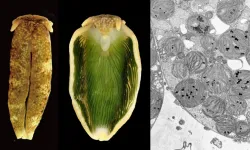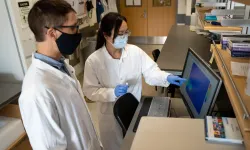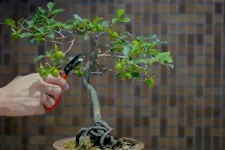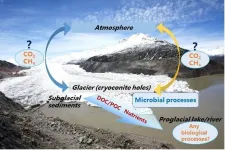Wolf pups born on Isle Royale, moose poised for decline
2021-07-15
(Press-News.org) The COVID-19 pandemic halted the in-person wintertime survey of wolves and moose on the island for the first time in 63 years. Consequently, there are no estimates of wolf or moose abundance for 2021, and the next estimates are scheduled in February 2022. But though the Isle Royale Winter Study didn't happen quite as planned, researchers were still able to visit the remote national park in the spring.
Now, fieldwork has resumed and Michigan Technological University researchers have already uncovered new information about these two iconic wildlife populations. In particular, wolves produced at least two litters of pups, and moose appear poised for decline.
In the Isle Royale Winter Study, Michigan Tech researchers share other significant developments about curating the world's largest moose bone collection, advances in understanding of wolf foraging behavior and the nutritional health of the moose population.
Key points:
The Isle Royale wolf population is likely growing. "We recovered footage of a group of four wolf pups taken in January 2021 by remote cameras at the east end of Isle Royale," said Sarah Hoy, research assistant professor in Michigan Tech's College of Forest Resources and Environmental Science (CFRES). "Additionally, observations of tracks and scats left by wolf pups last fall at two different locations suggest that there were probably two different litters of pups living at the east end of the island in September 2020."
Wolves are specialized foragers. "Wolf foraging behavior seems driven by minimizing the risks associated with killing large prey, like moose, even when the differences in vulnerability among individual moose might seem relatively subtle compared to when predators are choosing between different prey species," Hoy said.
Nutritional stress stacks the deck against moose, which holds significant implications for how moose will handle a warming climate. "We found that the nutritional health of moose was importantly influenced by how hot it is during the summer, and also by how deep the snow is in winter," Hoy said. "Moose tended to be more nutritionally stressed during winters with deep snow, which may be because deeper snow makes it more difficult for moose to move around and find food."
The moose population is likely declining. "Moose really struggled to find enough food this past winter," Hoy said. "Because there have been such large numbers of moose on the island over the last five years and moose ate branches faster than the trees can recover and replace them, the amount of food available to moose during winter has been getting progressively worse each year since 2017.
Winter ticks are worse than usual this year, as evidenced by moose with very little fur left in spring -- having scratched or bitten off almost all of their winter coats in an effort to rid themselves of the blood-sucking parasites. This is significant because blood loss to ticks can exacerbate the detrimental effects of food shortage. Despite the mild winter, depleted food supplies and ticks made life harder for the island's moose this year.
INFORMATION:
[Attachments] See images for this press release:
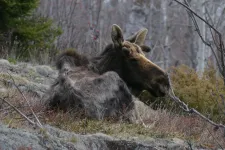
ELSE PRESS RELEASES FROM THIS DATE:
2021-07-15
Plants, algae and some bacteria are able to perform photosynthesis, which is the process of transforming sunlight energy into sugar. Animals are generally unable to use this process to acquire energy, but there are a few known exceptions to this. Some sea slugs take up chloroplasts from the algae that they consume into their cells. These chloroplasts retain their ability to perform photosynthetic activity within the animal cells for several months, and thus provide them with photosynthesis-derived nutrition. This process is called "kleptoplasty", and it has attracted much attention due to its amazing uniqueness in making animals photosynthetic for over 50 years.
A pressing question is how these sequestered chloroplasts retains their photosynthetic capability without algal nuclei. ...
2021-07-15
Since the Paris Climate Agreement that took effect in 2016, 121 countries have pledged to become carbon neutral by 2050 as the world tries to reduce its fuel consumption. The Korean government also unveiled its 2050 Carbon Neutral Strategy on December 7, 2020 and declared Carbon Zero, making transition to new and renewable energy a topic of conversation. Recently, a joint research team from POSTECH and Korea University has developed a radiative cooling material that can reduce energy consumption by selectively reflecting or transmitting sunlight.
A research team led by Professor Junsuk Rho, Ph.D. candidate Minkyung Kim, and Dr. Dasol Lee of POSTECH's departments of mechanical engineering and chemical engineering, and a team led by Professor Heon Lee and Soomin of the Department of Materials ...
2021-07-15
Combined perceptions of the risk and availability of cannabis influence the risk of cannabis use more than perceived risk and perceived availability alone, according to a new study at Columbia University Mailman School of Public Health. Researchers observed that those who perceived cannabis as low-risk and available were more likely to report using the drug in the past year and almost daily compared to those individuals who perceived cannabis as high-risk and unavailable. This is the first study to consider the joint effects of perceived risk and perceived availability. The results are published in the journal Drug and Alcohol Dependence.
"Our study described the evolution of joint perceptions of cannabis risk and availability from 2002-2018 and estimated the relationship between combined ...
2021-07-15
Adolescent girls and young women can and will use HIV prevention products with consistency, according to interim results of a study of two different methods: daily use of the antiretroviral (ARV) tablet Truvada® as oral pre-exposure prophylaxis (PrEP) and the monthly END ...
2021-07-15
Shining a beam of light into potentially contaminated water samples may hold the key to real-time detection of hydrocarbons and pesticides in water.
UBC Okanagan researchers are testing the use of fluorescence to monitor water quality. The results, they say, show great promise.
When a beam of light is shone into the water, it excites the electrons in molecules of certain compounds and causes them to emit light. The characteristics of the emitted light are like a fingerprint and can be used to identify certain contaminants, explains Nicolas Peleato, an assistant professor at UBCO's School of Engineering.
"The challenge with using this fluorescence approach is that ...
2021-07-15
Repairing complex electrical appliances is time consuming and rarely cost-effective. The working group led by Prof. Dr. Karl Mandel, Professorship of Inorganic Chemistry at Friedrich-Alexander-Universität Erlangen-Nürnberg (FAU), has now developed a smart microparticle that enables defective components in these appliances to be identified more quickly and easily by using light signals. In the long-term, this could make repairs easier and extend the operating life of devices. The results have been published in the journal Advanced Functional Materials.
To identify defective components in a device, particles known as supraparticles are applied to the individual parts. These particles measure between one and ten micrometres and under black light they provide information ...
2021-07-15
Fukuoka, Japan--At this very moment, the billions of neurons in your brain are using their trillions of connections to enable you to read and comprehend this sentence.
Now, by studying the neurons involved in the sense of smell, researchers from Kyushu University's Faculty of Medical Sciences report a new mechanism behind the biomolecular bonsai that selectively strengthens these connections.
How neuronal circuits remodel themselves over time, especially during early development, is an open question in neurobiology. At the start of neuronal development, neurons form excessive amounts of connections ...
2021-07-15
The cryosphere, a term used to describe the areas of the Earth's surface where water exists in solid form, plays an important role in regulating the Earth's climate. Due to cryospheric retreat; for example, the melting Greenland ice sheet in the Arctic, greenhouse gases that were formerly in "frozen storage" are now being released. High Mountain Asia, also known as the Tibetan Plateau, hosts the largest volume of glaciers outside the polar regions. However, Tibetan glaciers are currently excluded from global greenhouse gas budgets.
According to Shichang Kang, leader of a group of researchers who recently became the first team to measure the flux variations of greenhouse gases (CO2 and CH4) in typical glacial basins in High Mountain Asia, it's important that Tibetan glaciers are not ...
2021-07-15
New research will help doctors identify, treat and prevent potentially dangerous irregular heartbeats in patients with hypertrophic cardiomyopathy (HCM), a common heart condition in which the heart thickens and strains to pump blood.
These chaotic heart rhythms are known as atrial fibrillation. Atrial fibrillation can be asymptomatic, but it can lead to blood clots, stroke or even heart failure. The new research, from an international team of doctors and scientists, identifies risk factors for major atrial fibrillation outcomes, such as the need for procedures or hospitalization for more than 24 ...
2021-07-15
Scientists have developed a rapid, highly accurate test to detect antibodies against the spike protein of SARS-CoV-2 in human serum, opening a new avenue for understanding the full extent of the pandemic and evaluating the effectiveness of vaccines.
In the 18 months since the emergence of Covid-19 pandemic, great strides have been made in discovering and inventing various approaches to track and control the spread of the SARS-CoV-2 virus. Rapid and accurate diagnosis has always been vital in this regard. The gold standard since the beginning of the pandemic has been the RT-PCR method; however, it is time-consuming, labor-intensive, and requires sophisticated ...
LAST 30 PRESS RELEASES:
[Press-News.org] Wolf pups born on Isle Royale, moose poised for decline

